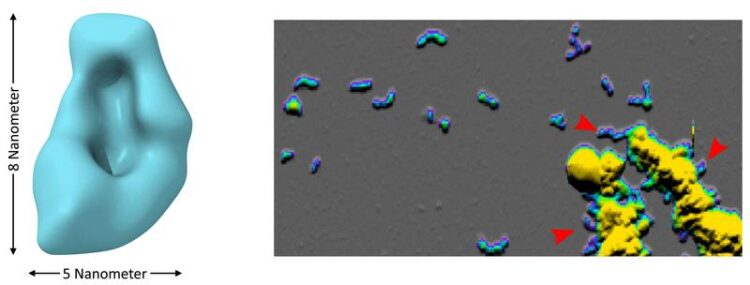New insights into the formation of toxic protein clumps

Small Aβ oligomers (left: cryo-electron microscopy) are clumps consisting of just a few Aβ molecules. They cluster together to form short, worm-like structures known as protofibrils (right: atomic force microscopy). In an acidic environment, the Aβ oligomers form very quickly and cluster to form large particles from which protofibrils are separated following neutralization of the pH value (right, red arrows).
Credit: Forschungszentrum Jülich, HHU Düsseldorf / Wolfgang Hoyer
Alzheimer’s research…
Small aggregates of proteins known as Aβ oligomers are suspected as the main cause for the development of Alzheimer’s disease. However, it is not yet clear where and under what conditions these toxic aggregates form. Researchers from Heinrich Heine University Düsseldorf and Forschungszentrum Jülich, together with partners from the University and University Hospital Cologne, have now found that a slightly acidic milieu is conducive to this development. In this environment, the oligomers form around 8,000 times quicker than for a neutral pH, as the scientists write in the journal Nature Communications. Such a slightly decreased pH also can be found in certain substructures of nerve cells.
The precise causes of Alzheimer’s disease are yet to be fully understood despite intensive research. For decades, there was a focus on characteristic protein deposits in the brains of Alzheimer’s patients that can be clearly seen with a microscope. Today, researchers instead concentrate on the “smaller relatives” of these deposits, oligomers. These are also accumulations of the amyloid-beta (Aβ) peptide, but on a much smaller scale typically comprising just a few units.
Aβ is not harmful in itself and can also be found in healthy individuals. It tends to assemble into toxic structures when, for instance, metabolic processes are disrupted in the brain. The biochemical processes that trigger these toxic oligomers are seen as the cause of Alzheimer’s disease. However, it is unclear where and how these oligomers form. In vitro, it has not yet been possible to replicate the process under realistic conditions. The amounts of Aβ required to do so are considerably higher than those that can be detected in the brain fluid.
In the study that has now been published, the researchers were able to show that the development of the oligomers is very highly dependent on the pH value. In slightly acidic conditions, they form 8,000 times quicker than for a neutral pH value. Such conditions can be found, for instance, in certain substructures of cells known as endosomes and lysosomes – small bubbles or vesicles that play a central role in the transport and degradation of substances in the cell.
“The amounts of Aβ found in these cell regions are thus sufficient to enable the formation of Aβ oligomers,” explains Wolfgang Hoyer from Heinrich Heine University Düsseldorf and Forschungszentrum Jülich.
Endosomes and lysosomes have long been a focal point of Alzheimer’s research. These are the sites where individual Aβ molecules develop in the first place through the breakdown of a precursor protein. They are also assembly points to which Aβ absorbed from the cell is transported. “Our results now indicate that endosomes and lysosomes are also the sites at which Aβ oligomers are preferentially formed,” Hoyer explains.
Study provides explanations for the maldistribution of protein
The researchers were also able to establish a link between the toxic Aβ oligomers and another feature of Alzheimer’s disease. After adding the Aβ oligomers, they observed an erroneous distribution of the tau protein within the nerve cells. The tau protein is a second protein that is closely linked with the progress of Alzheimer’s disease. Its occurrence in the wrong locations can lead to disruptions to the activity and structure of the nerve cells.
“The maldistribution and other pathological changes of the tau protein are critical to the loss of function of the nerve cells and the cognitive impairments of Alzheimer’s patients. The fact that the Aβ oligomers described here can trigger this pathological change of the tau protein in nerve cells underlines the high pathophysiological relevance of the study,” explains Hans Zempel from University Hospital Cologne.
The team of researchers was also able to investigate the size and form of the oligomers by means of cryo-electron microscopy and atomic force microscopy. “The findings obtained provide a basis to gain a better understanding of the special properties and impact of these critical protein aggregates,” Hoyer says. This will help with the development of diagnosis and treatment strategies that specifically target oligomers.
Journal: Nature Communications
DOI: 10.1038/s41467-021-24900-4
Method of Research: Experimental study
Subject of Research: Not applicable
Article Title: Endo-lysosomal Aβ concentration and pH trigger formation of Aβ oligomers that potently induce Tau missorting
Article Publication Date: 29-Jul-2021
All latest news from the category: Life Sciences and Chemistry
Articles and reports from the Life Sciences and chemistry area deal with applied and basic research into modern biology, chemistry and human medicine.
Valuable information can be found on a range of life sciences fields including bacteriology, biochemistry, bionics, bioinformatics, biophysics, biotechnology, genetics, geobotany, human biology, marine biology, microbiology, molecular biology, cellular biology, zoology, bioinorganic chemistry, microchemistry and environmental chemistry.
Newest articles

Innovative 3D printed scaffolds offer new hope for bone healing
Researchers at the Institute for Bioengineering of Catalonia have developed novel 3D printed PLA-CaP scaffolds that promote blood vessel formation, ensuring better healing and regeneration of bone tissue. Bone is…

The surprising role of gut infection in Alzheimer’s disease
ASU- and Banner Alzheimer’s Institute-led study implicates link between a common virus and the disease, which travels from the gut to the brain and may be a target for antiviral…

Molecular gardening: New enzymes discovered for protein modification pruning
How deubiquitinases USP53 and USP54 cleave long polyubiquitin chains and how the former is linked to liver disease in children. Deubiquitinases (DUBs) are enzymes used by cells to trim protein…



